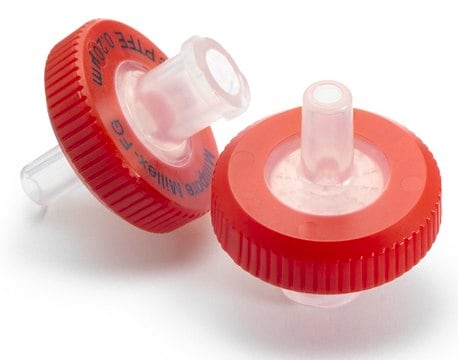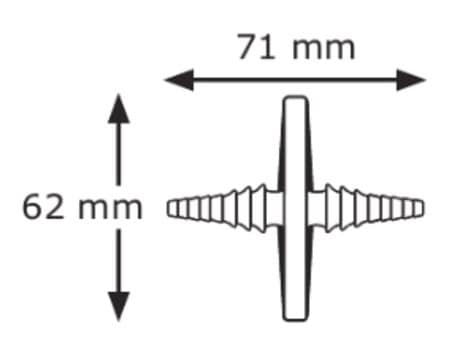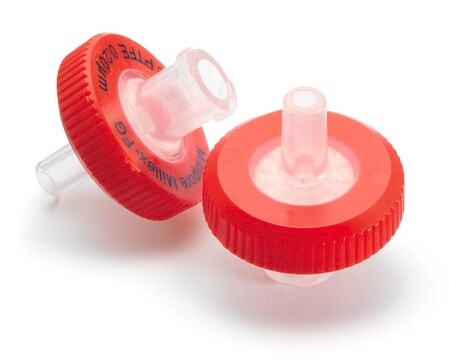SLFH025
Millex® hydrophobic PTFE syringe filter
pore size 0.45 μm, diam. 25 mm, non-sterile
Synonym(s):
0.45 μm PTFE syringe filter, Fluoropore® PTFE syringe filter, Millex-FH syringe filter, disposable syringe filter, syringe filter
About This Item
Recommended Products
material
PTFE membrane
high-density polyethylene housing
Quality Level
sterility
non-sterile
product line
Millex®
feature
holdup volume< 100 μL
hydrophobic
manufacturer/tradename
Millex®
parameter
45 °C max. temp.
7 bar max. inlet pressure (100 psi)
technique(s)
HPLC: suitable
analytical sample preparation: suitable
H
19.7 mm
diam.
25 mm
filtration area
3.9 cm2
volume
100 mL
matrix
Fluoropore®
pore size
0.45 μm
input
sample type organic solution(s)
fitting
female Luer-Lok® inlet
male Luer outlet slip
shipped in
ambient
General description
- Millex® syringe filters with Fluoropore® (PTFE) membrane are ideal for fine particle removal and clarification of organic solutions, vent filtration, and sterilization of gases.
- High-density polyethylene (HDPE) or polypropylene housing for low extractables.
- Membranes offer broad chemical compatibility and excellent solvent resistance for maximum sample recovery.
Legal Information
Not finding the right product?
Try our Product Selector Tool.
Storage Class
10-13 - German Storage Class 10 to 13
Certificates of Analysis (COA)
Search for Certificates of Analysis (COA) by entering the products Lot/Batch Number. Lot and Batch Numbers can be found on a product’s label following the words ‘Lot’ or ‘Batch’.
Already Own This Product?
Find documentation for the products that you have recently purchased in the Document Library.
Customers Also Viewed
Articles
HPTLC separation followed by UV detection of the bitter acid content in various hop samples.
HPTLC-MS was used to analyze stevioside and rebaudioside in artificial sweeteners, stevia plants, cola and isotonic drinks with a minimum of sample preparation.
Protocols
HPTLC was used to analyze caffeine in coffee. Filtration of coffee through a PTFE syringe filter was the only sample preparation. Quantitation was conducted with a TLC scanner.
HPTLC–MS analysis of quinine in tonic water and caffeine in coffee and cola drinks.
Our team of scientists has experience in all areas of research including Life Science, Material Science, Chemical Synthesis, Chromatography, Analytical and many others.
Contact Technical Service










